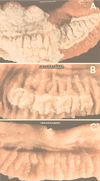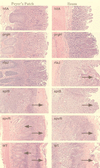Contribution of Salmonella typhimurium virulence factors to diarrheal disease in calves - PubMed (original) (raw)
Contribution of Salmonella typhimurium virulence factors to diarrheal disease in calves
R M Tsolis et al. Infect Immun. 1999 Sep.
Abstract
Limited knowledge is available about the virulence mechanisms responsible for diarrheal disease caused by Salmonella typhimurium. To assess the contribution to diarrheal disease of virulence determinants identified in models of infection, we tested a collection of S. typhimurium mutants for their ability to cause enteritis in calves. S. typhimurium strains carrying mutations in the virulence plasmid (spvR), Salmonella pathogenicity island 2 (SPI-2) (spiB), or SPI-5 (sopB) caused mortality and acute diarrhea in calves. An S. typhimurium rfaJ mutant, which is defective for lipopolysaccharide outer core biosynthesis, was of intermediate virulence. Mutations in SPI-1 (hilA and prgH) or aroA markedly reduced virulence and the severity of diarrhea. Furthermore, histopathological examination of calves infected with SPI-1 or aroA mutants revealed a marked reduction or absence of intestinal lesions. These data suggest that virulence factors, such as SPI-1, which are required during intestinal colonization are more important for pathogenicity in calves than are genes required during the systemic phase of S. typhimurium infection, including SPI-2 or the spv operon. This is in contrast to the degree of attenuation caused by these mutations in the mouse.
Figures
FIG. 1
Representative examples of the gross pathology of Peyer’s patch and mucosa of the terminal ileum of calves inoculated orally with 1010 CFU of different S. typhimurium strains. (A) Severe acute fibrinopurulent necrotizing enteritis with segmental or continuous pseudomembrane formation of calves inoculated with wild type (IR715), strain STN272 (spvR), or strain SVM255 (sigD). (B) Moderate to marked subacute fibrinopurulent enteritis often confined to Peyer’s patches of calves inoculated with STN119 (spiB) or STN166 (rfaJ). (C) Normal Peyer’s patch and ileal mucosa of calves inoculated with STN61 (hilA), STN162 (prgH), or CL1509 (aroA) or of uninoculated controls. Bar = 1 cm.
FIG. 2
Histopathology of Peyer’s patches and ileum from perinatal calves inoculated per os with 1010 CFU of the indicated strains of S. typhimurium per animal, photographed at a 40× magnification. Shown are hematoxylin-and-eosin-stained sections of Peyer’s patch (left column) and terminal ileum (right column). Short arrows indicate areas of marked lymphoid depletion; long arrows indicate zones of variable degrees of fibrinopurulent necrotizing ileitis at the mucosal surface.
Similar articles
- Analysis of the contribution of Salmonella pathogenicity islands 1 and 2 to enteric disease progression using a novel bovine ileal loop model and a murine model of infectious enterocolitis.
Coombes BK, Coburn BA, Potter AA, Gomis S, Mirakhur K, Li Y, Finlay BB. Coombes BK, et al. Infect Immun. 2005 Nov;73(11):7161-9. doi: 10.1128/IAI.73.11.7161-7169.2005. Infect Immun. 2005. PMID: 16239510 Free PMC article. - SspA is required for lethal Salmonella enterica serovar Typhimurium infections in calves but is not essential for diarrhea.
Tsolis RM, Adams LG, Hantman MJ, Scherer CA, Kimbrough T, Kingsley RA, Ficht TA, Miller SI, Bäumler AJ. Tsolis RM, et al. Infect Immun. 2000 Jun;68(6):3158-63. doi: 10.1128/IAI.68.6.3158-3163.2000. Infect Immun. 2000. PMID: 10816458 Free PMC article. - The Salmonella enterica serotype typhimurium effector proteins SipA, SopA, SopB, SopD, and SopE2 act in concert to induce diarrhea in calves.
Zhang S, Santos RL, Tsolis RM, Stender S, Hardt WD, Bäumler AJ, Adams LG. Zhang S, et al. Infect Immun. 2002 Jul;70(7):3843-55. doi: 10.1128/IAI.70.7.3843-3855.2002. Infect Immun. 2002. PMID: 12065528 Free PMC article. - Virulence Factors in Salmonella Typhimurium: The Sagacity of a Bacterium.
Dos Santos AMP, Ferrari RG, Conte-Junior CA. Dos Santos AMP, et al. Curr Microbiol. 2019 Jun;76(6):762-773. doi: 10.1007/s00284-018-1510-4. Epub 2018 May 21. Curr Microbiol. 2019. PMID: 29785632 Review. - Molecular pathogenesis of Salmonella enterica serotype typhimurium-induced diarrhea.
Zhang S, Kingsley RA, Santos RL, Andrews-Polymenis H, Raffatellu M, Figueiredo J, Nunes J, Tsolis RM, Adams LG, Bäumler AJ. Zhang S, et al. Infect Immun. 2003 Jan;71(1):1-12. doi: 10.1128/IAI.71.1.1-12.2003. Infect Immun. 2003. PMID: 12496143 Free PMC article. Review. No abstract available.
Cited by
- Recent Advances in the Detection of Antibiotic and Multi-Drug Resistant Salmonella: An Update.
Wu S, Hulme JP. Wu S, et al. Int J Mol Sci. 2021 Mar 28;22(7):3499. doi: 10.3390/ijms22073499. Int J Mol Sci. 2021. PMID: 33800682 Free PMC article. Review. - The dynamics of gut-associated microbial communities during inflammation.
Winter SE, Lopez CA, Bäumler AJ. Winter SE, et al. EMBO Rep. 2013 Apr;14(4):319-27. doi: 10.1038/embor.2013.27. Epub 2013 Mar 12. EMBO Rep. 2013. PMID: 23478337 Free PMC article. Review. - Predicting the Next Superspreader.
Chavez-Arroyo A, Bäumler AJ. Chavez-Arroyo A, et al. mSystems. 2023 Feb 23;8(1):e0119922. doi: 10.1128/msystems.01199-22. Epub 2023 Jan 19. mSystems. 2023. PMID: 36815796 Free PMC article. - Analysis of the contribution of Salmonella pathogenicity islands 1 and 2 to enteric disease progression using a novel bovine ileal loop model and a murine model of infectious enterocolitis.
Coombes BK, Coburn BA, Potter AA, Gomis S, Mirakhur K, Li Y, Finlay BB. Coombes BK, et al. Infect Immun. 2005 Nov;73(11):7161-9. doi: 10.1128/IAI.73.11.7161-7169.2005. Infect Immun. 2005. PMID: 16239510 Free PMC article. - Salmonella pathogenicity island 2 influences both systemic salmonellosis and Salmonella-induced enteritis in calves.
Bispham J, Tripathi BN, Watson PR, Wallis TS. Bispham J, et al. Infect Immun. 2001 Jan;69(1):367-77. doi: 10.1128/IAI.69.1.367-377.2001. Infect Immun. 2001. PMID: 11119526 Free PMC article.
References
- Ahmer B M, van Reeuwijk J, Watson P R, Wallis T S, Heffron F. Salmonella SirA is a global regulator of genes mediating enteropathogenesis. Mol Microbiol. 1999;31:971–982. - PubMed
- Bajaj V, Hwang C, Lee C A. HilA is a novel ompR/toxR family member that activates the expression of Salmonella typhimurium invasion genes. Mol Microbiol. 1995;18:715–727. - PubMed
Publication types
MeSH terms
LinkOut - more resources
Full Text Sources
Other Literature Sources
Miscellaneous

